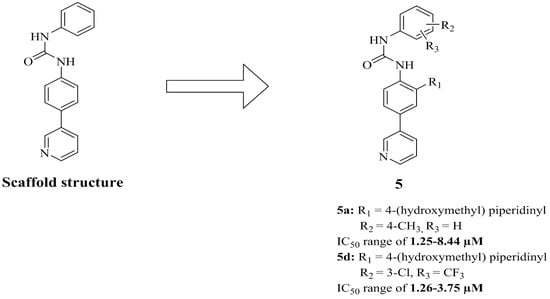Synthesis and In Vitro Antiproliferative Activity of New 1-Phenyl-3-(4-(pyridin-3-yl)phenyl)urea Scaffold-Based Compounds
Abstract
:1. Introduction
2. Results and Discussion
2.1. Chemistry
2.2. In Vitro Antiproliferative Activities against the NCI-60 Cell Line Panel
2.2.1. Single Dose Testing
2.2.2. Five Dose Testing
3. Materials and Methods
3.1. General Information
3.2. General Method for Synthesis of Compounds 2a–c
3.3. General Method for Synthesis of Compounds 3a–c
3.4. General Method for the Palladium Catalyzed Reduction of Nitrobenzenes 3a–c to the Corresponding Anilines 4a–c
3.5. General Procedure for the Synthesis of Urea Derivatives 5a–n
4. Conclusions
Acknowledgments
Author Contributions
Conflicts of Interest
References
- Vogelstein, B.; Kinzler, K.W. The multistep nature of cancer. Trends Genet. 1993, 9, 138–141. [Google Scholar] [CrossRef]
- Vogelstein, B.; Kinzler, K.W. Cancer genes and the pathways they control. Nat. Med. 2004, 10, 789–799. [Google Scholar] [CrossRef] [PubMed]
- Dumas, J. Protein kinase inhibitors from the urea class. Curr. Opin. Drug Discov. Dev. 2002, 5, 718–727. [Google Scholar]
- Canal, N.; Garattini, S.; Tessari, L. Peripheral effect of new urea derivatives with hypoglycemic action. Boll. Soc. Ital. Biol. Sper. 1956, 32, 491–494. [Google Scholar] [PubMed]
- Faidallah, H.M.; Khan, K.A.; Asiri, A.M. Synthesis and biological evaluation of new 3-trifluoromethylpyrazolesulfonyl-urea and thiourea derivatives as antidiabetic and antimicrobial agents. J. Fluor. Chem. 2011, 132, 131–137. [Google Scholar] [CrossRef]
- Li, Y.; Tian, K.; Qin, A.; Zhang, L.; Huo, L.; Lei, L.; Shen, Z.; Song, H.; Feng, Z. Discovery of novel urea derivatives as dual-target hypoglycemic agents that activate glucokinase and PPARγ. Eur. J. Med. Chem. 2014, 76, 182–192. [Google Scholar] [CrossRef] [PubMed]
- Brown, J.R.; North, E.J.; Hurdle, J.G.; Morisseau, C.; Scarborough, J.S.; Sun, D.; Korduláková, J.; Scherman, M.S.; Jones, V.; Grzegorzewicz, A. The structure–activity relationship of urea derivatives as anti-tuberculosis agents. Bioorg. Med. Chem. 2011, 19, 5585–5595. [Google Scholar] [CrossRef] [PubMed]
- Doub, L.; Richardson, L.; Herbst, D.; Black, M.; Stevenson, O.; Bambas, L.; Youmans, G.; Youmans, A. Some phenylthiourea derivatives and their antituberculous activity. J. Am. Chem. Soc. 1958, 80, 2205–2217. [Google Scholar] [CrossRef]
- Kale, R.R.; Kale, M.G.; Waterson, D.; Raichurkar, A.; Hameed, S.P.; Manjunatha, M.; Reddy, B.K.; Malolanarasimhan, K.; Shinde, V.; Koushik, K. Thiazolopyridone ureas as DNA gyrase b inhibitors: Optimization of antitubercular activity and efficacy. Bioorg. Med. Chem. Lett. 2014, 24, 870–879. [Google Scholar] [CrossRef] [PubMed]
- Keche, A.P.; Hatnapure, G.D.; Tale, R.H.; Rodge, A.H.; Birajdar, S.S.; Kamble, V.M. A novel pyrimidine derivatives with aryl urea, thiourea and sulfonamide moieties: Synthesis, anti-inflammatory and antimicrobial evaluation. Bioorg. Med. Chem. Lett. 2012, 22, 3445–3448. [Google Scholar] [CrossRef] [PubMed]
- Tale, R.H.; Rodge, A.H.; Hatnapure, G.D.; Keche, A.P. The novel 3,4-dihydropyrimidin-2(1H)-one urea derivatives of N-aryl urea: Synthesis, anti-inflammatory, antibacterial and antifungal activity evaluation. Bioorg. Med. Chem. Lett. 2011, 21, 4648–4651. [Google Scholar] [CrossRef] [PubMed]
- Zheng, Q.-Z.; Cheng, K.; Zhang, X.-M.; Liu, K.; Jiao, Q.-C.; Zhu, H.-L. Synthesis of some n-alkyl substituted urea derivatives as antibacterial and antifungal agents. Eur. J. Med. Chem. 2010, 45, 3207–3212. [Google Scholar] [CrossRef] [PubMed]
- Sashidhara, K.V.; Rosaiah, J.N.; Tyagi, E.; Shukla, R.; Raghubir, R.; Rajendran, S.M. Rare dipeptide and urea derivatives from roots of Moringa Oleifera as potential anti-inflammatory and antinociceptive agents. Eur. J. Med. Chem. 2009, 44, 432–436. [Google Scholar] [CrossRef] [PubMed]
- Chen, J.-N.; Wang, X.-F.; Li, T.; Wu, D.-W.; Fu, X.-B.; Zhang, G.-J.; Shen, X.-C.; Wang, H.-S. Design, synthesis, and biological evaluation of novel quinazolinyl-diaryl urea derivatives as potential anticancer agents. Eur. J. Med. Chem. 2016, 107, 12–25. [Google Scholar] [CrossRef] [PubMed]
- Gable, K.L.; Maddux, B.A.; Penaranda, C.; Zavodovskaya, M.; Campbell, M.J.; Lobo, M.; Robinson, L.; Schow, S.; Kerner, J.A.; Goldfine, I.D. Diarylureas are small-molecule inhibitors of insulin-like growth factor I receptor signaling and breast cancer cell growth. Mol. Cancer Ther. 2006, 5, 1079–1086. [Google Scholar] [CrossRef] [PubMed]
- Kansal, N.; Silakari, O.; Ravikumar, M. 3D-QSAR studies of various diaryl urea derivatives of multi-targeted receptor tyrosine kinase inhibitors: Molecular field analysis approach. Lett. Drug Des. Discov. 2008, 5, 437–448. [Google Scholar] [CrossRef]
- Gandin, V.; Ferrarese, A.; Dalla Via, M.; Marzano, C.; Chilin, A.; Marzaro, G. Targeting kinases with anilinopyrimidines: Discovery of N-phenyl-N′-[4-(pyrimidin-4-ylamino)phenyl] urea derivatives as selective inhibitors of class III receptor tyrosine kinase subfamily. Sci. Rep. 2015, 5, 16750. [Google Scholar] [CrossRef] [PubMed]
- Luo, C.; Tang, K.; Li, Y.; Yin, D.; Chen, X.; Huang, H. Design, synthesis and in vitro antitumor evaluation of novel diaryl urea derivatives bearing sulfonamide moiety. Sci. China Chem. 2013, 56, 1564–1572. [Google Scholar] [CrossRef]
- Xuan, W.; Ding, W.; Hui, H.-X.; Zhang, S.-Q. Synthesis and cytotoxic activity of diaryl urea derivatives with a 4-methylpiperazinylcarbonyl moiety. Med. Chem. Res. 2013, 22, 3857–3862. [Google Scholar] [CrossRef]
- Zhao, Y.-F.; Liu, Z.-J.; Zhai, X.; Ge, D.-D.; Huang, Q.; Gong, P. Synthesis and in vitro antitumor activity of novel diaryl urea derivatives. Chin. Chem. Lett. 2013, 24, 386–388. [Google Scholar] [CrossRef]
Sample Availability: Samples are not available from the authors. |
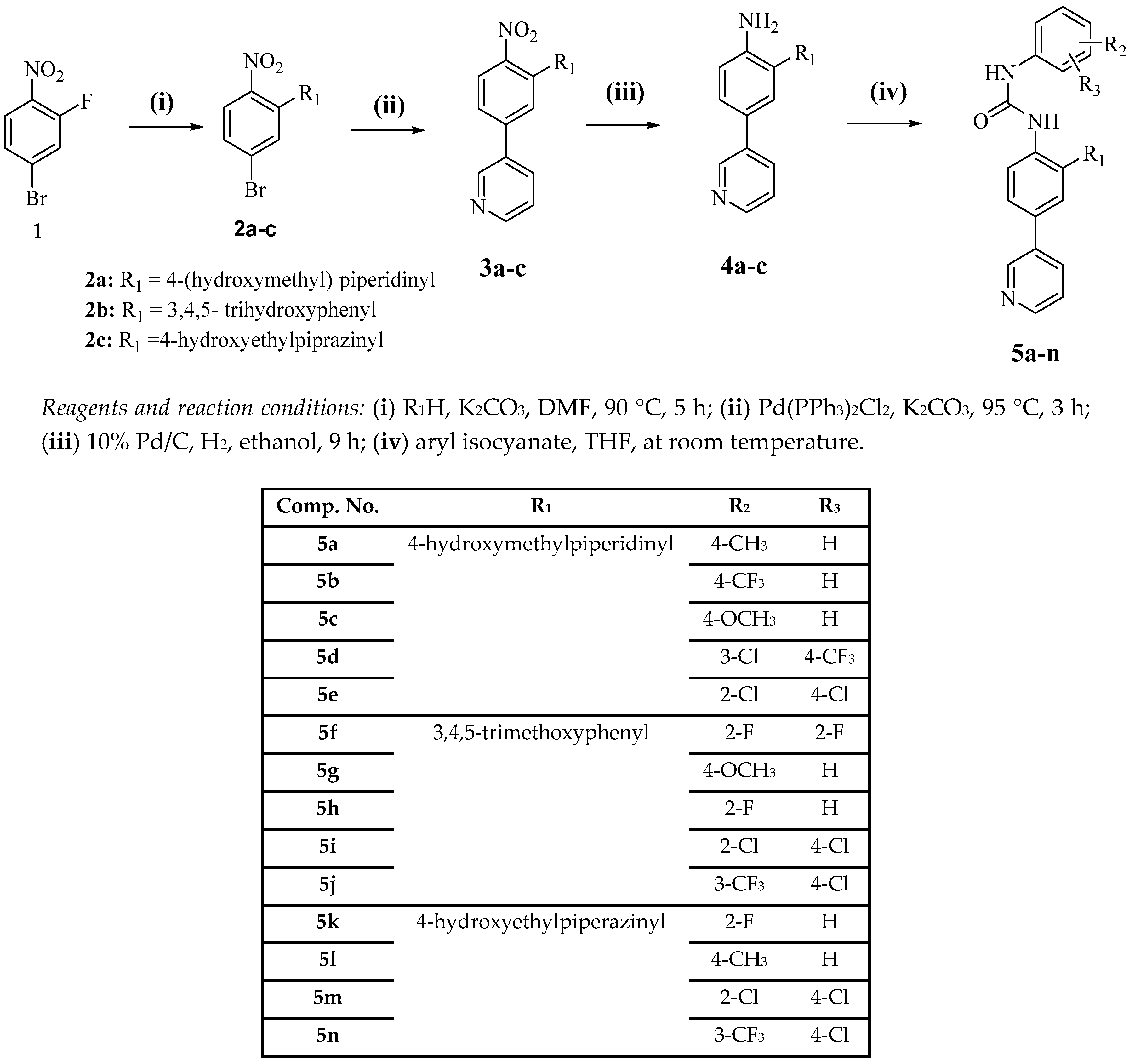
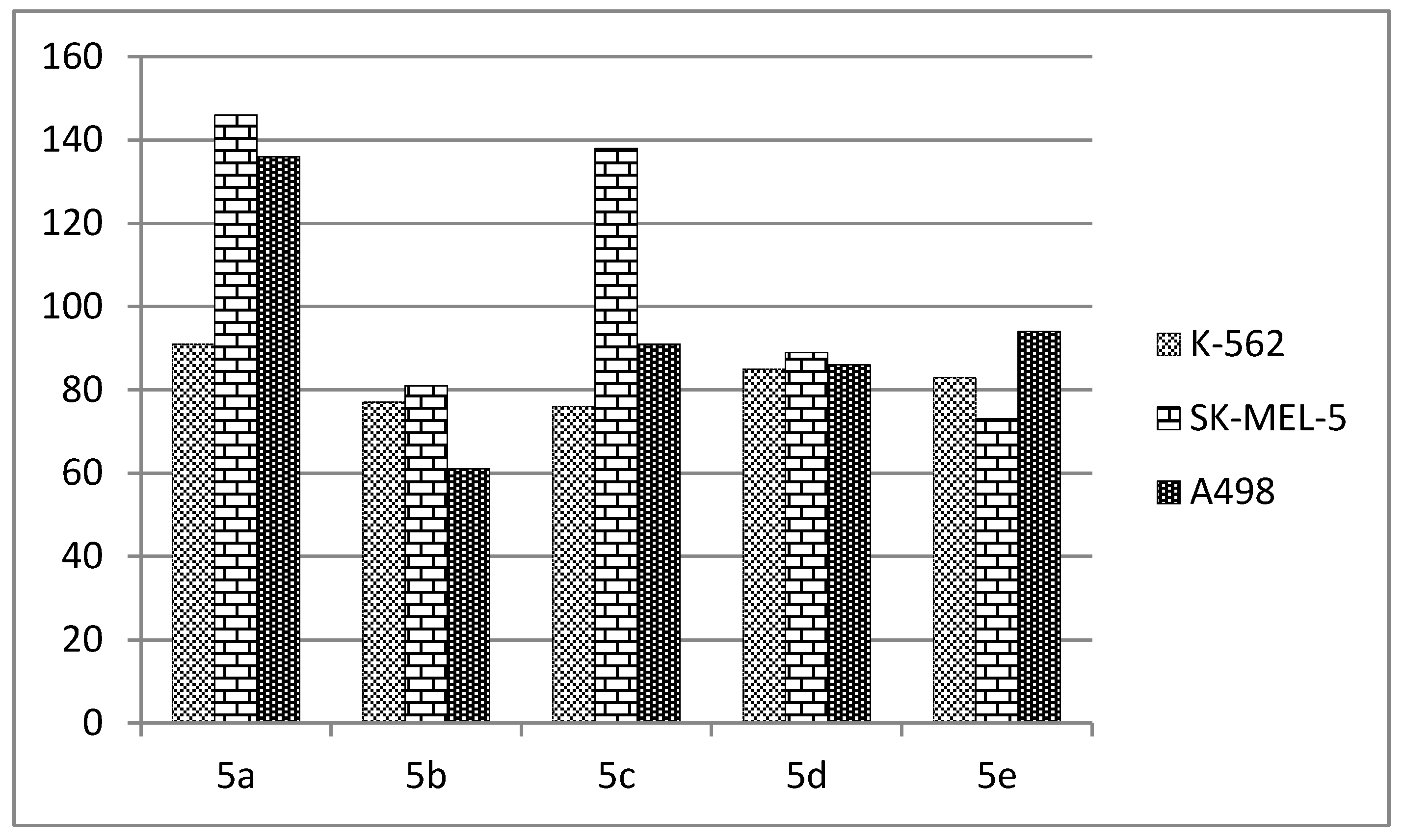
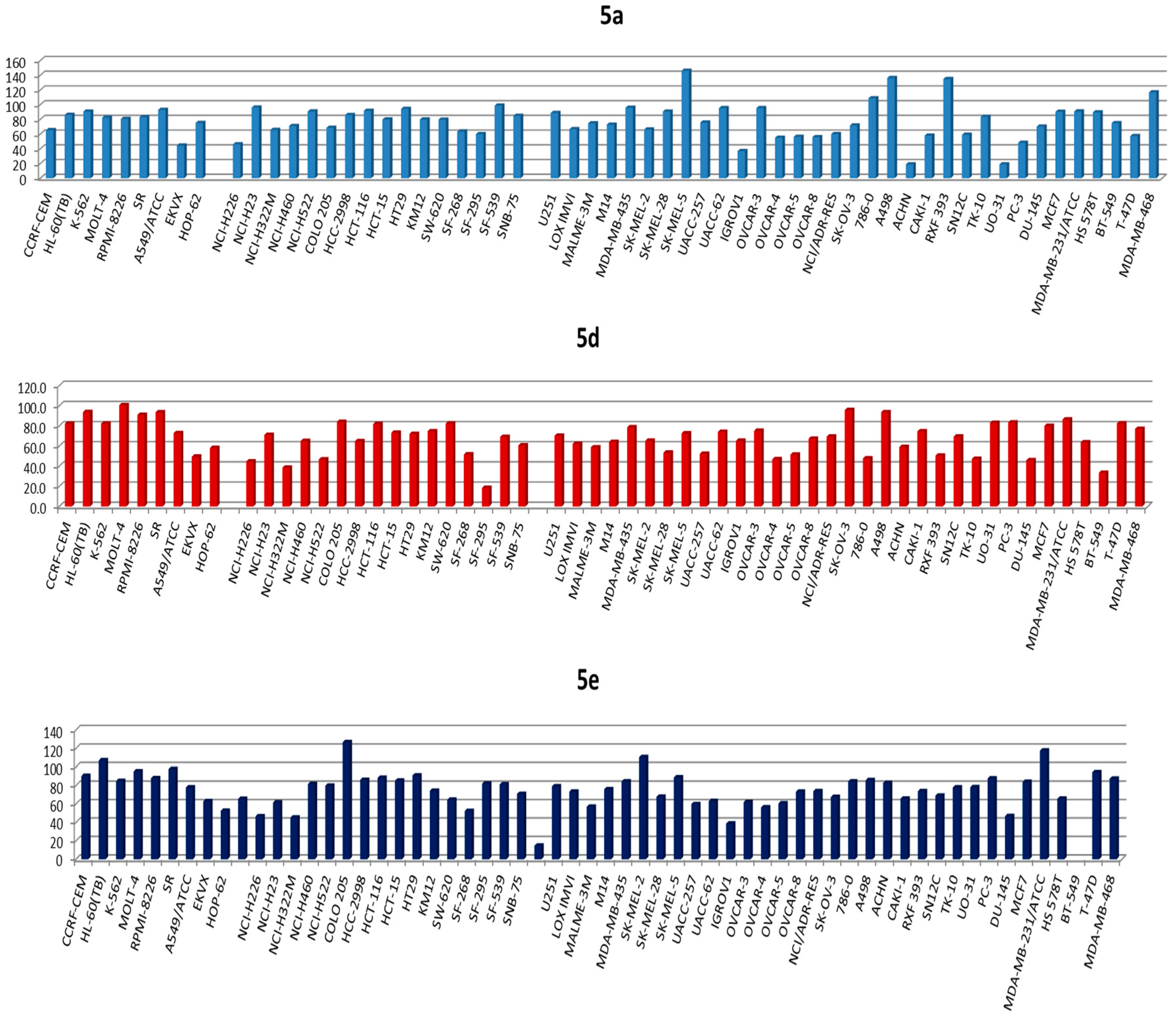
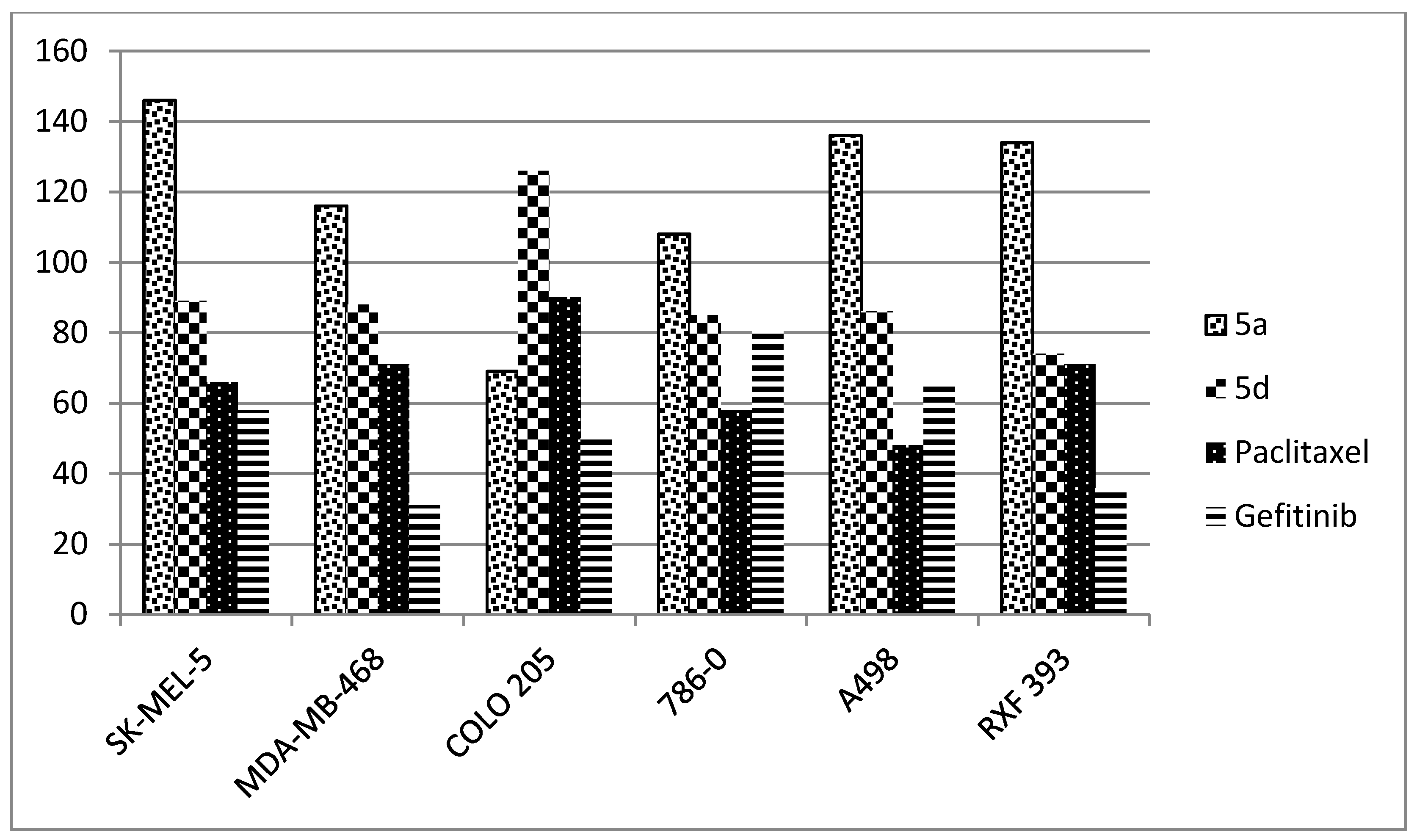
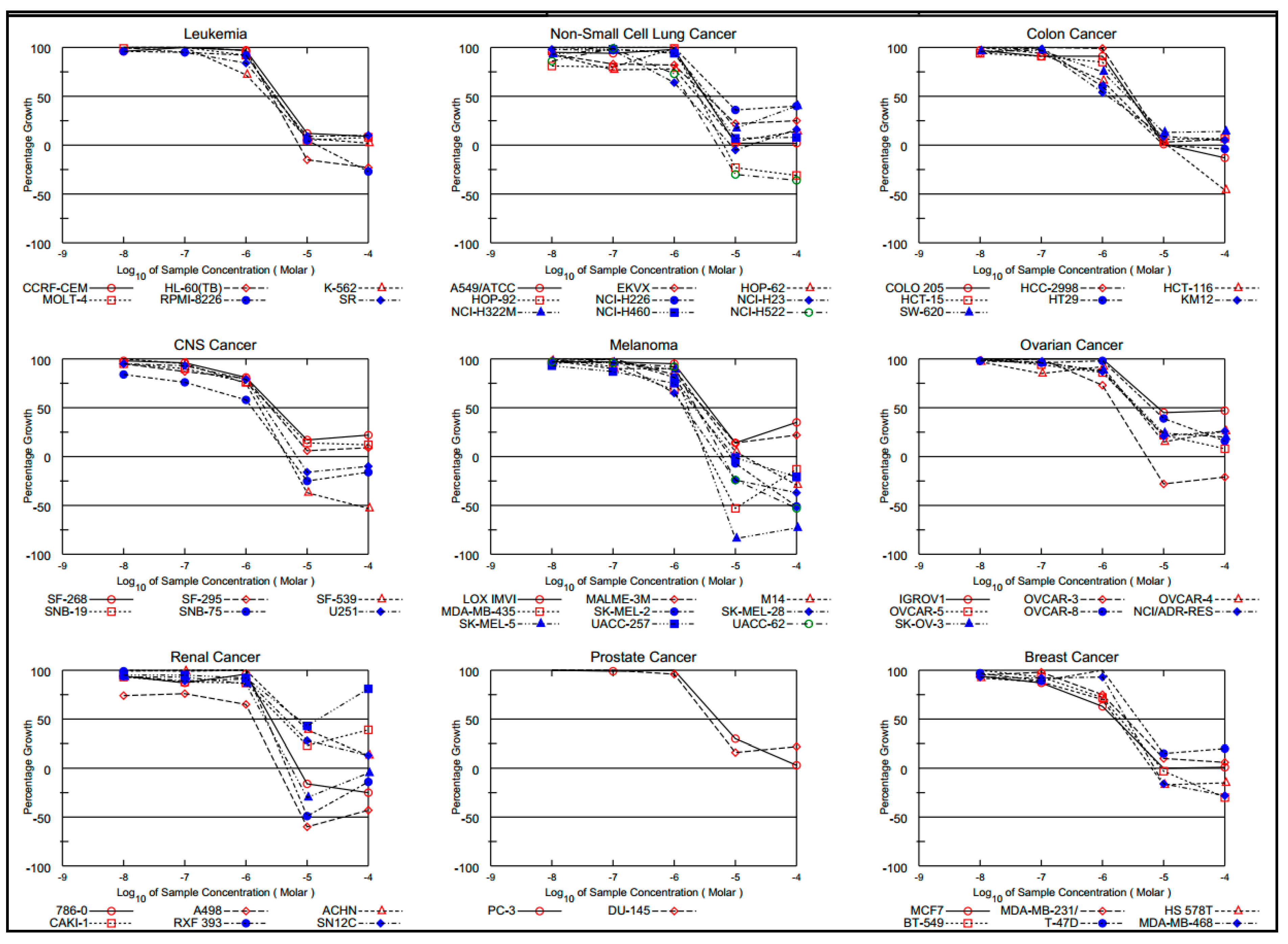
| Cell Lines | Percentage Inhibition (at 10 μM) | |||||
|---|---|---|---|---|---|---|
| 5a | 5b | 5c | 5d | 5e | ||
| Leukemia | CCRF-CEM | 90.3 | 82.2 | |||
| HL-60(TB) | 86.1 | 106.9 | 93.7 | |||
| K-562 | 90.6 | 84.9 | 82.3 | |||
| MOLT-4 | 82.4 | 95.2 | 100.6 | |||
| RPMI-8226 | 80.6 | 87.9 | 90.8 | |||
| SR | 82.9 | 97.7 | 93.4 | |||
| NSCLC | A549/ATCC | 93.0 | ||||
| NCI-H23 | 96.0 | |||||
| NCI-H460 | 81.5 | |||||
| NCI-H522 | 90.7 | |||||
| Colon cancer | COLO 205 | 126.6 | 83.9 | |||
| HCC-2998 | 85.9 | 86.1 | ||||
| HCT-116 | 91.6 | 87.5 | 88.2 | 81.9 | ||
| HCT-15 | 85.2 | |||||
| HT29 | 94.3 | 90.2 | 90.8 | |||
| KM12 | ||||||
| SW-620 | 82.4 | |||||
| CNS cancer | SF-295 | 82.2 | ||||
| SF-539 | 98.7 | 84.9 | 81.1 | |||
| SNB-19 | 84.7 | |||||
| U251 | 88.7 | |||||
| Melanoma | MDA-MB-435 | 95.7 | 84.5 | |||
| SK-MEL-2 | 110.3 | |||||
| SK-MEL-28 | 90.6 | 81.3 | ||||
| SK-MEL-5 | 146.1 | 80.0 | 138.3 | 88.7 | ||
| UACC-62 | 95.3 | |||||
| Ovarian cancer | OVCAR-3 | 95.3 | ||||
| SK-OV-3 | 95.7 | |||||
| Renal Cancer | 786-0 | 108.7 | 84.4 | |||
| A498 | 136.2 | 90.9 | 85.7 | 93.6 | ||
| ACHN | 82.7 | |||||
| RXF 393 | 134.8 | |||||
| TK-10 | 83.5 | |||||
| UO-31 | 83.0 | |||||
| Prostate Cancer | PC-3 | 87.6 | 83.4 | |||
| Breast Cancer | MCF7 | 90.2 | 83.8 | 80.0 | ||
| MDA-MB-231/ATCC | 90.7 | 117.5 | 86.4 | |||
| HS 578T | 89.4 | |||||
| T-47D | 94.4 | 82.5 | ||||
| MDA-MB-468 | 116.6 | 87.4 | ||||
| Comp. No. | Mean % Growth |
|---|---|
| 5a | 22 |
| 5b | 59 |
| 5c | 53 |
| 5d | 24 |
| 5e | 32 |
| 5f | 99 |
| 5g | 97 |
© 2018 by the authors. Licensee MDPI, Basel, Switzerland. This article is an open access article distributed under the terms and conditions of the Creative Commons Attribution (CC BY) license (http://creativecommons.org/licenses/by/4.0/).
Share and Cite
Al-Sanea, M.M.; Ali Khan, M.S.; Abdelazem, A.Z.; Lee, S.H.; Mok, P.L.; Gamal, M.; Shaker, M.E.; Afzal, M.; Youssif, B.G.M.; Omar, N.N. Synthesis and In Vitro Antiproliferative Activity of New 1-Phenyl-3-(4-(pyridin-3-yl)phenyl)urea Scaffold-Based Compounds. Molecules 2018, 23, 297. https://doi.org/10.3390/molecules23020297
Al-Sanea MM, Ali Khan MS, Abdelazem AZ, Lee SH, Mok PL, Gamal M, Shaker ME, Afzal M, Youssif BGM, Omar NN. Synthesis and In Vitro Antiproliferative Activity of New 1-Phenyl-3-(4-(pyridin-3-yl)phenyl)urea Scaffold-Based Compounds. Molecules. 2018; 23(2):297. https://doi.org/10.3390/molecules23020297
Chicago/Turabian StyleAl-Sanea, Mohammad M., Mohammed Safwan Ali Khan, Ahmed Z. Abdelazem, So Ha Lee, Pooi Ling Mok, Mohammed Gamal, Mohamed E. Shaker, Muhammad Afzal, Bahaa G. M. Youssif, and Nesreen Nabil Omar. 2018. "Synthesis and In Vitro Antiproliferative Activity of New 1-Phenyl-3-(4-(pyridin-3-yl)phenyl)urea Scaffold-Based Compounds" Molecules 23, no. 2: 297. https://doi.org/10.3390/molecules23020297
APA StyleAl-Sanea, M. M., Ali Khan, M. S., Abdelazem, A. Z., Lee, S. H., Mok, P. L., Gamal, M., Shaker, M. E., Afzal, M., Youssif, B. G. M., & Omar, N. N. (2018). Synthesis and In Vitro Antiproliferative Activity of New 1-Phenyl-3-(4-(pyridin-3-yl)phenyl)urea Scaffold-Based Compounds. Molecules, 23(2), 297. https://doi.org/10.3390/molecules23020297




